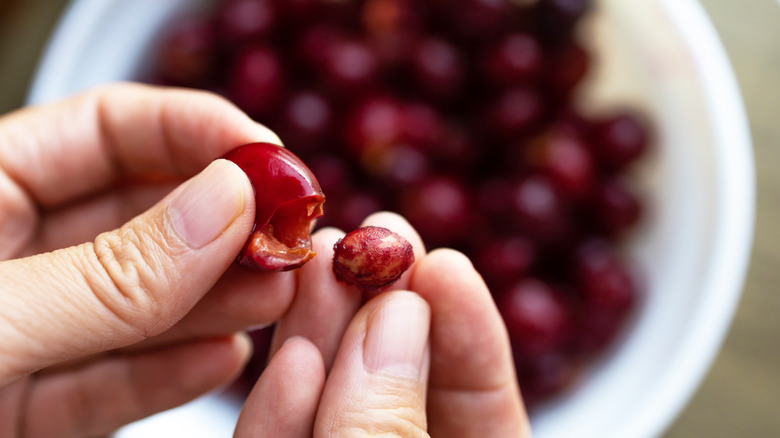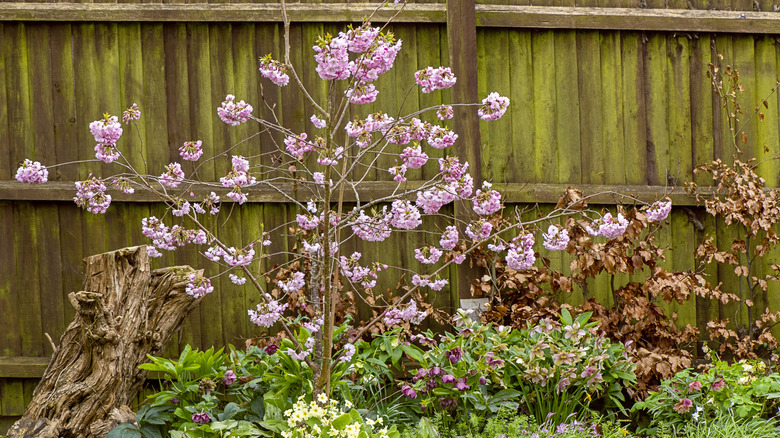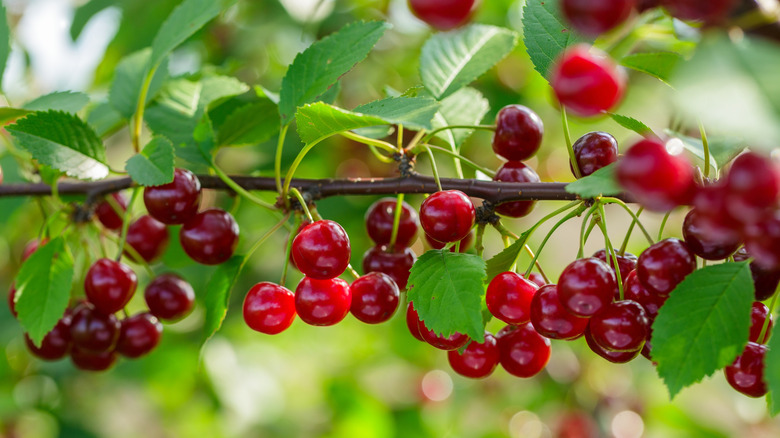Why You Might Want To Think Twice Before Growing A Cherry Tree From A Seed
Regrowing produce from scraps is a rewarding experience: What would otherwise go in the trash becomes a new source of food. But when it comes to cherry pits, you may not get the results you're hoping for. Chances are, those store-bought cherries were propagated with a method called grafting, which ensures more reliably delicious cherries than growing from seed. Grafting is the best way for home gardeners to grow a cherry tree as well.
In nature, cherry trees cross-pollinate with each other, so each seed contains a different set of DNA than its parent trees. This is a handy evolution because it allows a wide variety of characteristics to develop. But it also means that there's no way to predict the result of planting any specific cherry seed. It won't necessarily look or taste like the cherry you got it from. Often it tastes worse, and the tree may grow larger than is practical for some gardens.
Additionally, growing a cherry tree from seed is tricky and time-consuming. To successfully germinate cherry seeds, you have to soak them, give them a cold treatment in the fridge for 10 weeks, and then ensure they get enough water and sunlight until they sprout. If your efforts are successful, it can take up to 10 years to get your first crop of mystery cherries.
A better way to grow a cherry tree
In order to get a predictable result every time, cherry trees are typically grown by grafting, or joining two plants together. The branch of a tree with the desired type of fruit is grafted onto a separate rootstock, or root system, which has been selected for its strength and disease resistance. The two sections combine to grow into one healthy tree, and these are the cherry trees you will find for sale at gardening stores. (The same is true for many other fruit trees, including apples and peaches.)
When buying a young cherry tree, you can choose the exact type of cherry you want. You can also see the approximate time of harvest and how big the mature tree will get. None of that is possible when growing from seed. Additionally, a grafted cherry tree will grow much more quickly than a seed-grown one: depending on the size and age of the tree, around two to four years after planting.
Enjoy 10 to 15 quarts of cherries per year from a dwarf tree or 30 to 50 quarts from a full-size tree. In order to get a good crop, make sure your cherry tree has full sunlight and well-draining, fertile soil. Some cherry trees require another tree nearby that to cross-pollinate with to produce fruit. Others, including all sour cherry tree species, are "self-fertile" and can be grown solo. Cherry trees are generally hardy from USDA zones 4 to 7.
What to do with cherry pits instead
If you're not tied to a specific type of cherry (or even getting edible fruit at all), you can still plant cherry seeds in your garden as a fun experiment. It's possible to end up with yummy fruit one day even though it's not guaranteed. Before planting, you'll need to remove the seeds from the pit by rinsing the leftover fruit off and cutting it open. Soak the seeds in warm water for a couple of hours, then give them a cold treatment by putting them in the fridge for 10 weeks. Store the seeds in a damp paper towel in a plastic bag.
After that, plant the seeds in a seed tray and place them in a sunny spot, keeping the soil moist until they germinate in about two weeks. Plant your cherry seedlings outside after the last frost of the season is over and the seedlings are at least 8 to 12 inches tall.
Not sold on mystery cherries but still don't want them to go to waste? Cherry pits are compostable, though they can take a while to break down in cold compost bins. To prevent any pits that haven't been decomposed from ending up in your compost, sift the compost through a quarter-inch mesh screen before adding it to your plants.


